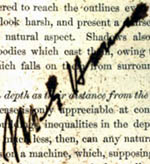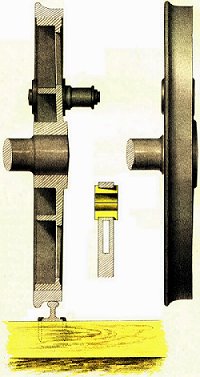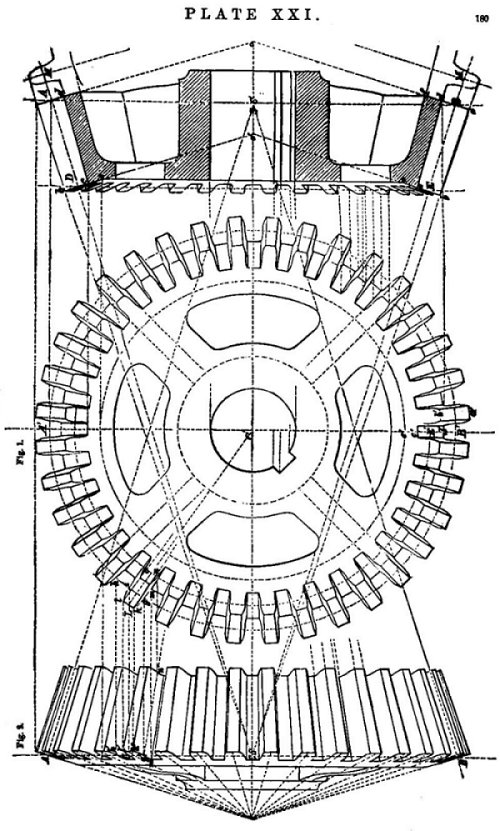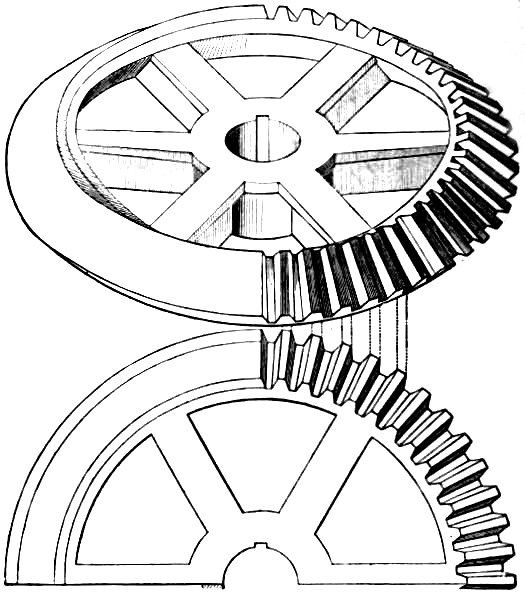Milton Grosvenor Howe
Today, an intimate look at America emerging. The University of Houston's College of Engineering presents this series about the machines that make our civilization run, and the people whose ingenuity created them.
You find the oddest things in library stacks. Take this 1857 drafting text -- filled with crisp images of architecture, machinery, perspective, topography -- colored plates have even been added. The line between art and engineering blurs in this pre-Civil War window upon America.
 The son of one Milton G. Howe gave this book to our library. Howe, an early Texan, had studied civil engineering at Dartmouth and he'd worked on railways in Illinois. But when war began, he joined a Confederate cavalry regiment. In 1866, war is finished and he signs this book with an ill-cut quill pen. He signs both in front, and across random pages inside. His ink, alas, spreads and obscures his name.
The son of one Milton G. Howe gave this book to our library. Howe, an early Texan, had studied civil engineering at Dartmouth and he'd worked on railways in Illinois. But when war began, he joined a Confederate cavalry regiment. In 1866, war is finished and he signs this book with an ill-cut quill pen. He signs both in front, and across random pages inside. His ink, alas, spreads and obscures his name.
Howe was quite successful. He became chief engineer of the Texas Central Railroad, then its general superintendent. And, when the time came, this Confederate veteran sent his son off to Phillips Academy and MIT, back in Yankee Massachusetts. His son, who also went by the name Milton, worked his whole life as a civil engineer -- first on rail, then on roads and hydraulic structures.
And Howe's father-in-law, Andrew Briscoe, was a rail pioneer as well. Briscoe was a lawyer who became Chief Justice of my own Harris County, then turned to developing our embryonic Texas rail system. Like Howe, Briscoe had also done his time in war -- more successfully than Howe. He was one of Sam Houston's commanders at the Battle of San Jacinto, where Santa Ana was defeated and Texas briefly became a sovereign nation.
 Still, these lives were about the technologies, not the wars, that defined us. And images in this old book reveal the texture of those times. Huge bevel gears and air pumps, Victorian houses, complex machinery displayed in even more complex projections, a lovingly shaded view of a heavy lag screw alongside a pastoral view of a country bungalow. And, in the back, a chromolithograph plate uses a railway wheel to illustrate how to do a color drawing.
Still, these lives were about the technologies, not the wars, that defined us. And images in this old book reveal the texture of those times. Huge bevel gears and air pumps, Victorian houses, complex machinery displayed in even more complex projections, a lovingly shaded view of a heavy lag screw alongside a pastoral view of a country bungalow. And, in the back, a chromolithograph plate uses a railway wheel to illustrate how to do a color drawing.
One technology, yet to be invented when the book was made, was wood pulp paper. That's our good fortune. These cotton rag pages are still supple, although some witch's brew of chemicals and fibers was mixed in with the paper pulp. Most pages are stained varying shades of brown.
Now we go to computers for images such as these; but, when we do, something changes. The human mind no longer has to stretch quite the way it did to produce these pictures. The complexity we see on paper was first conquered in the human mind. That mental capacity equipped people in Howe's day to build America so rapidly and to build it so well. I used the word intimacy at the beginning, and I hope you now see why I did. For here -- in this old book -- mind, image, and artifact become quite inseparable.
I'm John Lienhard, at the University of Houston, where we're interested in the way inventive minds work.
(Theme music)
Appletons' Cyclopaedia of Drawing, Designed as a Text-Book for the Mechanic, Architect, Engineer, and Surveyor, Comprising Geometrical Projection, Mechanical, Architectural and Topographical Drawing, Perspective and Isometry. (W. E. Worten, ed.) (New York: D. Appleton and Company, 1866). This is Milton Grosvenor Howe's copy. The first printing was done in 1857.
Howe's son, J. Milton Howe (1874-?) had a distinguished career as a Civil Engineer. He is listed in a number of 20th-century biographical sources. I am grateful to Barbara Kemp, UH Library, for finding genealogical records of Milton G. Howe (1834-1902), Andrew and Mary Briscoe (1810-1849, 1819-1902) and others of this distinguished family. There is a fairly substantial record of Andrew Briscoe, for his role in Texas history. He was one of the signers of the Texas Declaration of Independence.
All images are from the Appletons' Cyclopaedia of Drawing.


Representing a bevel gear accurately is quite a feat. Doing so in perspective is fiendishly complex.